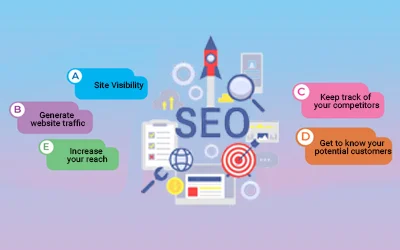In 2024, website performance will be more crucial than ever. With the increasing use of mobile devices and shrinking user attention spans, slow websites won't stay in the game anymore. Fortunately, with some strategic website performance optimization techniques, you can drastically boost your website speed and deliver blazing-fast experiences to your visitors.
Why Website Performance Matters in 2024
The importance of website for business holds a crucial place. Because your business website marks your online presence in the market and will determine if your visitors will turn into customers. Research shows higher website performance leads to:
- Increased conversion rates and more sales
- Improved search engine rankings
- Lower bounce rates
- Better user engagement and loyalty
14 Website Performance Optimization Techniques
Let's discuss 14 website performance optimization techniques to employ in 2024:
1. Select a Right Hosting Provider
The foundation of website performance optimization is the hosting provider. Pay attention to hardware configurations while selecting hosting providers.
Please look for these features:
- SSD-powered storage for faster access times
- Latest generation processors for efficient computing
- High-memory servers to support caching and simultaneous connections
- Global CDN integration for faster content delivery
- Optimized software stacks like Nginx web server
Avoid overselling by analyzing the provider's hosting plans carefully during website development.
2. Compress Images
Images tend to be webpage heavy-hitters, affecting loading times and slowing down websites. Run images through compressors like TinyPNG and Kraken.io, or use WordPress compression plugins.
Set up automated image compression flows in your website development pipeline. Compressed images load faster, reducing website load times.
3. Minify HTTP Requests
Every CSS, JS, or font file requires a separate HTTP request. Tools like Grunt can combine multiple files into fewer files, minimizing requests. Minification removes unnecessary characters from code files, reducing their size. Coupled with compression, minification decreases page weight and speeds up loading.
Import only critical CSS required for initial page load and load other CSS asynchronously. Consider making this process a part of your build automation workflow.
4. Utilize Browser Caching for Repeat Visits
Browser caching stores website files locally, so repeat visits don't require re-downloading assets.
While first-time visits will be slightly slower, enabling caching minimizes resource loading on subsequent visits as assets are stored locally.
Configure cache lifetime for resources through headers or service workers to avoid stale content.
This significantly improves website speed optimization and performance.
5. Employ a CDN for Faster Content Distribution
CDNs have edge servers distributed geographically closer to visitors, ensuring swift content delivery and minimizing lag no matter the location. Integrate CDNs seamlessly by configuring CName records to route traffic through them.
Content Delivery Networks (CDNs) store static website files on numerous edge servers close to the users. This allows the website to be delivered faster and more efficiently, as the content is cached and readily available at multiple locations.
Serving files from nearby CDN servers minimizes latency and improves performance.
6. Load Critical Assets Early, Defer Non-Essentials
Lazy loading defers non-critical assets loading until needed. This technique of website speed optimization reduces initial loading time and boosts performance.
Not all assets impact initial page loads. Using code splitting and lazy loading ensures only critical files are prioritized first while non-essential assets get deferred. This way, the main content gets rendered quickly, giving the perception of faster load times.
7. Optimize Database
Unoptimized databases lead to slow queries, hurting performance. Database optimization techniques like indexing and caching boost query speed.
Streamline your code and optimize databases to reduce unnecessary bloat and improve site performance.
Serving files from nearby CDN servers minimizes latency and improves performance.
8. Enable GZIP Compression
GZIP shrinks file sizes by eliminating redundant data. To speed up your website's loading times, it's best to compress the files before sending them to the browser. This can be done by significantly reducing the file sizes.
This compression technique significantly decreases data transfer sizes, particularly benefiting text-based files (HTML, CSS, JavaScript) and improving load times.
This reduces bandwidth usage and will positively impact the website speed optimization process.
9. Use a Fast DNS Provider
Using a quality DNS provider minimizes DNS lookup times and speeds up site connections. DNS mapping domain names to site IPs should be lightning-quick.
Shop around for DNS providers that offer global infrastructure and connectivity via anycast networking to trim lookup times substantially.
Always keep DNS software up-to-date. This enhances user experience as it is one of the critical web performance optimization techniques.
10. Optimize for Mobile
With growing mobile usage, to make a website responsive for mobile is key for performance. Employ responsive design, compress images, and reduce HTTP requests.
Utilize responsive design frameworks like Bootstrap or implement AMP (Accelerated Mobile Pages) to create a seamless experience across various devices and screen sizes.
This step is crucial for website performance optimization as most users come from mobile interfaces only.
11.Monitor Redirect Chains
Too many unnecessary redirects drag down performance by adding additional HTTP requests. Regularly audit and optimize redirects, ensuring they're efficiently implemented to maintain a streamlined site structure.
Monitor redirect chains periodically and eliminate unneeded redirects.
12. Limit Web Font Usage
Though appealing, overusing web fonts hurt loading times. Limit custom web fonts to only those necessary.
Select and use web-safe fonts wisely. Opt for efficient font loading techniques and limit the variety of fonts to enhance site speed.
13.Address Bad Plugins
Bad plugins can significantly degrade website performance optimization. So, it is important to identify and replace poorly performing plugins regularly.
Regularly assess and eliminate plugins that negatively impact your site's performance, and look for user-friendly and efficient alternatives.
14. Use Prefetching
Prefetch instructs the browser to fetch assets before users navigate to them. This reduces perceived loading times.
Leverage prefetching to anticipate user actions and preload resources in advance. Employ techniques like to fetch resources like fonts, stylesheets, or scripts before they're explicitly requested. Doing so significantly improves the perceived load time, resulting in a faster browsing experience for the user.
Employing these website performance optimization techniques will help fast-track your website in 2024. Remember that blazing-fast speed directly uplifts visitor experience.
Conclusion
In today's competitive online environment, the importance of these techniques of website performance optimization for businesses cannot be overstated. A responsive, fast-loading website improves user satisfaction and positively impacts search engine rankings and conversions.
Investing in a professional web development company in Delhi that understands web performance optimization techniques can be a strategic move. This is because such techniques hold significant importance for businesses. You can rely on Invoidea to employ these techniques and leverage experienced professionals' expertise to create a website for business. This way, your business website will stand out in performance, responsiveness, and user experience.










